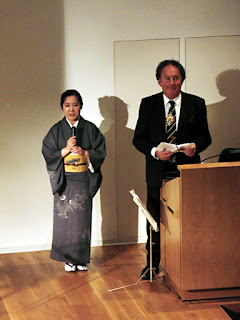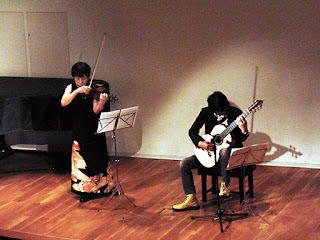Minori Nakaune, violinist
At 8:15 AM on August 6th 1945, the American B29 bomber Enola Gay flew over Hiroshima and dropped the atomic bomb.
The population of Hiroshima at the time was around 350,000 and out of those, around 140,000 were instantly killed by a sea of fire, some were vaporised leaving behind only their shadow, some were burnt all over and died jumping into the river....it was like a scene from hell.
20 minutes after the atomic bomb dropped, black rain fell and the fatalities increased.
At the time, America was said to have declared that for the next 70 years, Hiroshima would be a barren wasteland, yet three days after the bomb dropped, the trains were restarted by those suffering from influenza and leukaemia and gave a signal of hope to those who survived the blast.
The people who actually operated these trains were in fact 17year old female students, since all the fit men were fighting for their country.
My uncle Taro who was 23, was in the police academy located within 1km of the blast radius when the bomb dropped.
There are many records available now of this time of personal experiences, and after doing a bit of research, it appears my uncle perished after jumping into the river in an attempt to cool the burns.
Many of the bodies recovered from the river were collectively gathered to the state school grounds and burnt, then buried. The same space was used soon after to grow potatoes to prevent a food shortage.
A few years later, the deceased bones were transferred to the cemetery at the Hiroshima peace park.
My parents were living in the rural outskirts but went in to the city straight after the bomb dropped to search for Taro, hence, they became classed as radiation victims.
And although it was indirect, I was born on June the following year thus I am a second generation radiation victim.
I have been told by many relatives that I had an uncanny resemblance to Taro, so I have tried to make the most out of my life for his sake as well.
70 years on, Hiroshima is anything but a barren wasteland, even the Cherry trees which received the blast all that time ago still bloom immensely.
This year I once again attended the Peace Memorial event which I prayed, and in the evening lit a lamp down the nearby river motoyasu-gawa in honour of those who have since lost their lives.
1945年8月6日午前8時15分、アメリカ軍のB29エノラ・ゲイは広島に原子爆弾を落としました。当時、広島市の人口はおよそ35万人。そのうち、およそ14万人が一瞬にして火の海の中で亡くなりました。影だけを残して消えた人、黒焦げになって川に飛び込んで死んだ人・・・。その光景はまるで地獄だったそうです。
原爆落下の20分後にには黒い雨が降り、さらに犠牲者は増えました。
アメリカは当時「広島は今後70年は不毛だ。町をそのまま保存せよ。」と言ったそうですが、白血病や食糧難、インフレ等で苦しみながら、広島市民は3日後には市内電車を走らせ、破壊から立ち上がる勇気を残った人々に与えました。その運転を担ったのは、何と17歳の女学生達でした。男たちは殆どが戦地に行っていたからです。
私の叔父の太郎さんは、23歳の時、広島の中心地(落下点1KM以内)にあった警察学校にいて被爆しています。現在は体験集など多くの資料があるので、彼の消息を調べましたら、まず、川に入り、そこで亡くなったようです。多くの亡骸は、周辺の国民学校の校庭で焼かれ、そこに埋められました。さらに、その土地に食糧難を防ぐためにイモ類の栽培もしたそうです。その数年後には、犠牲者の遺骨は平和公園内の共同墓地に移されました。
私の両親は田舎に疎開していましたが、間もなく太郎さんを捜すために広島市に入り、入市被爆者となっています。私は翌年の6月6日に生まれましたので、間接的ではありますが、被爆二世ということになります。どうも顔立ちが太郎さんに似ているとも言われて、叔父の分も一生懸命に生きていこうとしているところです。
70年後の広島は、不毛どころか、原爆を受けた桜も毎年見事な花を咲かせています。今年も平和記念式典に参加して平和を祈り、その夜には近くの元安川で灯籠を流して霊魂に捧げました。
2015年9月4日 中畝みのり






























.jpg)















